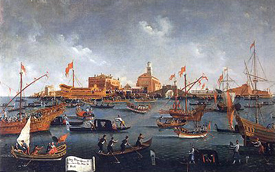 The
Doge of the Serenissima used this rite to demonstrate the Republic’s
dominion in the gulf. The
Doge of the Serenissima used this rite to demonstrate the Republic’s
dominion in the gulf.
Aside from legend and tradition, the ceremony probably had Byzantine
origins, or could even have been based on ancient pagan propitiators.
The doge and his entourage embarked on the Bucintoro. On reaching
the mouth of San Nicolò port, the Doge threw a gold ring
into the sea.
A huge and colourful procession of decorated boats with representatives
of the guilds and the city’s major corporations followed the
Bucintoro.
|
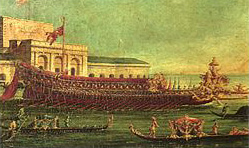 The
Bucintoro The
Bucintoro
This was the Serenissima’s flagship and it embodied the pomp
and splendour of the Republic thanks to its ornaments and decoration.
It was used for water processions, for greeting ambassadors and the
most important visitors of the time, for festivities and principally
on Ascension Day.
|
| |
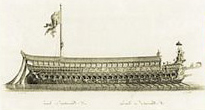
It had two decks: the lower level held the rowers, whilst the upper
held a large salon, covered with a canopy and decorated in red velvet.
It had 48 windows and seating for 90 people. It was reserved for the
highest authorities of the Republic. The Doge’s sumptuous throne
on the stern added the finishing touch. |
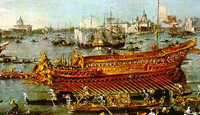
The last Bucintoro launched in 1728 was approximately 35 metres long,
with 42 oars and 168 oarsmen.
With the fall of the Republic in 1797, the French troops pillaged
the boat, stripping it of its adornments.
|
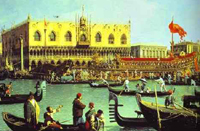 The ceremony The ceremony
On Ascension Day the Bucintoro was brought before the Saint Mark’s
Square: it waited for the Doge and the Council to embark, along with
prestigious guests and foreign ambassadors.
The cortege consisted of commanders, equerries, church dignitaries,
clergymen and chancellors. During the journey, musicians from the
Marciana chapel played madrigals
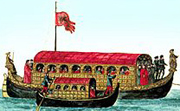 Once
past the island of St. Elena, the Bucintoro was joined by a boat carrying
the Patriarch who, once on board, blessed the sea. Immediately afterwards,
the Doge threw the ring into the water to seal the marriage. Once
past the island of St. Elena, the Bucintoro was joined by a boat carrying
the Patriarch who, once on board, blessed the sea. Immediately afterwards,
the Doge threw the ring into the water to seal the marriage.
|
|